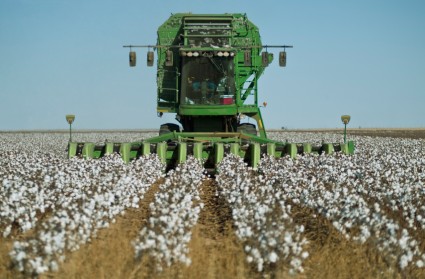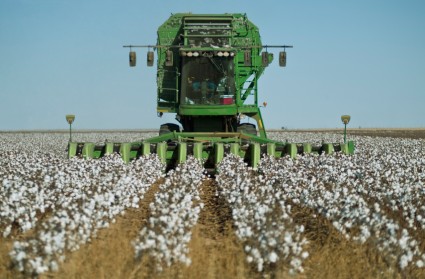 Like the food you eat, the clothes on your back come from somewhere. If you wear cotton, that “somewhere” is ultimately a farm (with detours at a textile mill, a clothes factory, etc).
Like the food you eat, the clothes on your back come from somewhere. If you wear cotton, that “somewhere” is ultimately a farm (with detours at a textile mill, a clothes factory, etc).
Growing vast monocrops of cotton, it turns out, is a dirty business. Globally, cotton occupies 2.4 percent of cropland — and burns through 16 percent of the insecticides used every year, the Environmental Justice Foundation reports.
Indeed, conventional cotton production in the United States has long required a veritable monsoon of poisons. Cotton can even give even industrial corn a run for its money in terms of environmental impact. According to the U.S. Geological Survey, pesticide applications for cotton run “3 to 5 times greater per hectare than applications of pesticides to corn.”
To try and stem the chemical cascade, farmers in cotton country have largely switched to seeds genetically modified to contain a pesticide and to withstand Roundup, Monsanto’s broad-based herbicide. Today, upwards of 60 percent of cotton grown in the U.S. contains those traits.
Trouble is, that “solution” to cotton’s chemical dependence is already failing. In cotton country, Roundup-resistant “superweeds” are a large and growing problem, forcing farmers to employ a toxic cocktail of herbicides to control weeds. And now, Monsanto recently revealed, a strain of cotton bollworms has developed resistance to the company’s widely planted pesticide-carrying cotton strain. Who knows what new poison concoctions will be needed to exterminate these “superbugs”?
In short, while industrial cotton production works well for agrichemical companies and the global textile industry that spins cheap cotton into fat profit, it pretty much sucks for the environment. As for the farmers, their cost of production — think all of those agrichemicals and seeds — is generally higher than what the market pays them for their harvest. What keeps them in business is commodity subsidies. Between 1995 and 2009, U.S. cotton farmers took in about $30 billion in subsidies, EWG reports — roughly equal to what wheat farmers got, and more than any other group besides corn farmers.
Given industrial cotton farming’s dependence on chemicals and government payouts, it’s no wonder more and more consumers are demanding organic cotton. Get this, from the Memphis Commercial Appeal:
Although still tiny, sales of organic fibers, mostly cotton, also grew rapidly in the U.S., climbing from $69 million in 2002 to $521 million in 2009. In contrast to the 10 percent increase in sales of organic bedding and clothing in 2009, sales of nonorganics fell by 1 percent.
Naturally, rather than help farmers reach this growing market by phasing out toxic chemicals, the agribusiness lobby is scrambling to re-brand current practices as sustainable. The Commercial Appeal continues:
To counter the perception that organic is better for consumers and the environment, the Cordova [,Tenn.]-based National Cotton Council of America has joined with Cotton Inc. and other major agribusiness and farm commodity groups to come up with a definition of “sustainable” that they hope will become part of U.S. Department of Agriculture regulations much as a definition of “organic” did nearly a decade ago.
A group called the Keystone Center — whose board includes execs from agrichemical giants Monsanto, DuPont, and Dow — has organized an effort by Monsanto, The Fertilizer Institute, and other groups to “write a technical definition for sustainable,” the Commercial Appeal reports.
Evidently, after rigorous study and soul-searching, the coalition settled upon a definition of “sustainable” cotton production that … blesses current practices. Whether consumers will actually take Keystone’s “sustainable” label seriously is another question.
Now, none of this is surprising. Monsanto would like to sustain the lucrative market for its herbicides and the cotton seeds designed to withstand them; no mystery there. The real scandal is the USDA’s role in serving that end. Rather than using research cash to help farmers reach the growing organic market, the agency is sitting on its hands while farmers are stuck right where they are: between expensive chemical inputs and low cotton prices .
According to the Commercial Appeal, growing U.S. demand for clothes made with organic cotton is largely satisfied by overseas producers: “There are no more than 60 growers of organic cotton in the U.S. — and none in the Mid-South.” The Mid-South is one of the few major cotton-growing regions in the nation. Cotton farmers who are now struggling with superweeds and high seed prices might be tempted to go organic to cut costs and earn a premium price in the marketplace. The problem is that there has been no research on how to control weeds without chemicals — and without such knowledge in place, few farmers will gamble on new growing practices.
The Commercial Appeal talks to a pioneering Missouri farmer named Steve McKaskle, who grew organic cotton for 16 years until a 2006 tornado destroyed his family’s cotton gin and other equipment. McKaskle now grows organic vegetables, and the reporter asks him why other Mid-South cotton farmers hadn’t gone organic:
McKaskle said the chief problem with organic cultivation in the Mid-South is not the climate — it’s the lack of money available to develop processes and techniques that would help large commercial organic farmers.
Government researchers can only answer the questions they set out to answer. If the problem before them is how to sustain chemical-intensive cotton production, their research will promote a kind of treadmill of new chemical-intensive solutions: for example, using herbicides developed by Syngenta to clean up messes caused by Monsanto’s herbicide.
A more interesting problem, from the perspective of the public who pays the bills, would be: how can we grow cotton in a way that doesn’t foul waterways and turn farmers into wards of the state? If USDA researchers put significant resources into answering that question, I’d wager, we’d see organic agriculture flower in cotton country.



